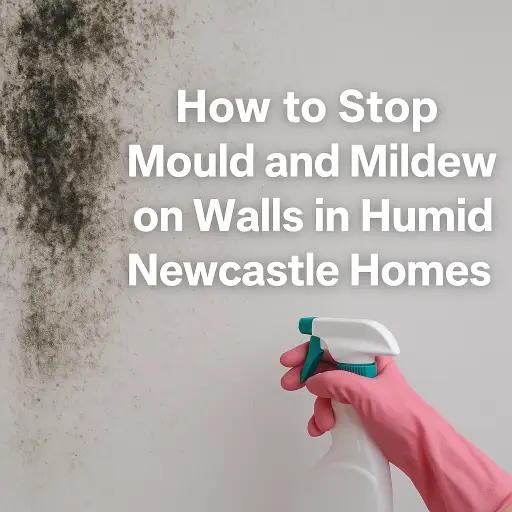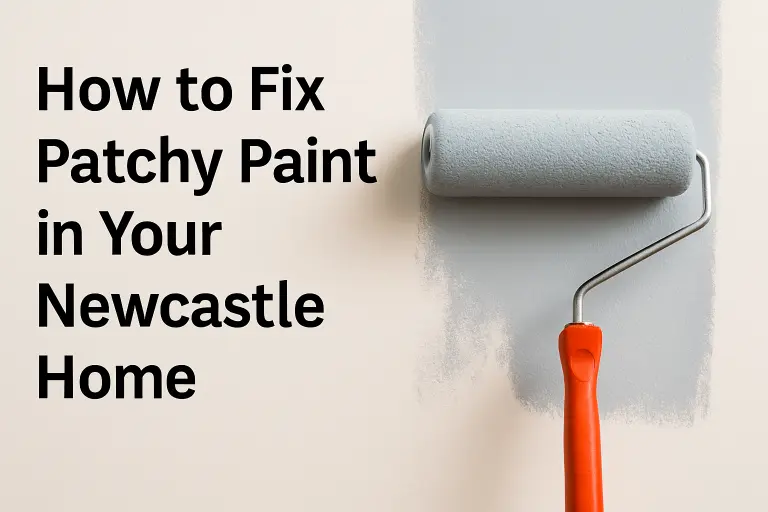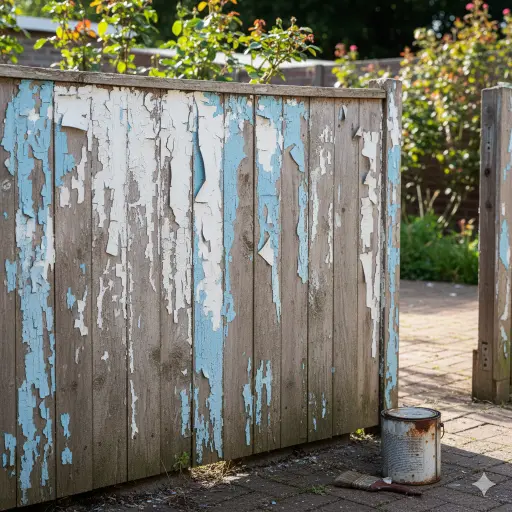How to Stop Mould and Mildew on Walls in Humid Newcastle Homes
If a black patch keeps creeping back on your wall after a wet week, you’re not alone. Newcastle’s air stays humid for most of the year. That humidity feeds mould. The good news: you can stop it for good with a simple plan.
Newcastle’s coastal air is beautiful, but it’s also humid for much of the year. That moisture fuels mould and mildew. Paint fails. Rooms smell musty. Asthma can flare up. The good news: with the right prep, ventilation, and paint system, you can stop mould at the source—and keep it from coming back.
If you want help from house painters Newcastle homeowners trust, we’ll also show you when to call a pro—and what to ask them so you get a long-lasting result.
1) Why mould loves Newcastle’s climate
Newcastle has high humidity throughout the year. At Nobbys Head, the average 9 am relative humidity is 75% across the year. Monthly values sit around 77–80% in summer and 68–74% in spring. Even at 3 pm, humidity averages 66% across the year. That’s enough moisture to keep walls damp, especially in bathrooms and south-facing rooms.
| Month | 9am RH % | 3pm RH % |
|---|---|---|
| Jan | 77 | 72 |
| Feb | 80 | 74 |
| Mar | 79 | 72 |
| Apr | 78 | 66 |
| May | 79 | 64 |
| Jun | 79 | 63 |
| Jul | 77 | 59 |
| Aug | 72 | 56 |
| Sep | 69 | 59 |
| Oct | 68 | 64 |
| Nov | 72 | 68 |
| Dec | 74 | 71 |
Why this matters: If indoor surfaces stay wet, mould can start in 24–48 hours. Dry fast after leaks or floods.
2) What exactly is growing on your walls (and why)
Mould is a type of fungus. It thrives on moisture + food (dust, paint film, paper on plasterboard). It turns up in wet or poorly-ventilated spots: bathrooms, laundries, kitchens, wardrobes, wallpapered rooms, and behind furniture.
The cause is usually one (or more) of these:
- Condensation: Warm, moist indoor air touches a cooler wall. Water condenses. Over time, this keeps the paint damp.
- Leaks: Roof, gutters, pipes. Even minor drips keep a cavity wet.
- Rising/lateral damp: Ground moisture travelling up walls. Poor subfloor airflow makes it worse
- Locked-in moisture: Tight homes with no real exhaust to outdoors. Newcastle bathrooms and laundries need true ducting outside under the NCC.
3) Where mould shows up first in Newcastle homes
- Bathrooms and laundries: Steam; often small windows; fans that vent into the roof (which is no longer allowed for new work).
- South-facing rooms: Cooler walls; more condensation.
- Wardrobes and behind big furniture: Trapped air; lower surface temps.
- Near the coast: Salt spray and moisture stress paints. Coastal conditions can reach up to ~3 km inland and need 6-monthly inspections of exterior coatings.
| Room | Must exhaust to | Quick test | If failing |
|---|---|---|---|
| Bathroom | Outdoors (not roof space) | Feel air at external grille | Add duct kit + timer |
| Laundry | Outdoors | Dryer steam outside? | Hard-duct or vent kit |
| Kitchen | Outdoors (best) | Paper test at hood | Duct to eave/wall |
| Toilet | Outdoors | Check outlet | Add back-draught damper |
4) Your 48-hour action plan to stop the spread (simple and safe)
Goal: Dry it, clean it, and stay safe.
Why 48 hours? After a leak or flood, aim to dry items within 24–48 hours to prevent growth.
Step 1 – Vent + dry now
- Open windows when the weather allows. Use fans to move air across the damp area.
- Run a dehumidifier if you have one (keep indoor RH below ~60%). The EPA advises keeping humidity under 60% indoors.
Step 2 – Suit up and isolate
3. Wear gloves and eye protection when cleaning. Keep kids and pets away.
Step 3 – Clean the mould (NZ/Aus-friendly methods)
4. Use mild detergent or diluted vinegar (4 parts vinegar to 1 part water) on hard, non-porous surfaces. Wipe, then dry fully.
5. If it doesn’t shift, use diluted bleach (250 mL bleach in 4 L water). Keep the room well ventilated and dry the surface after.
Step 4 – Check what can’t be saved
6. Water-damaged carpet, underlay, and soft furnishings may need removal if not dried in time.
Step 5 – Fix the source
7. Repair leaks, clear gutters, and seal around penetrations.
8. If you can smell damp but can’t see it, get a licensed plumber or building consultant. Interstitial condensation can hide in walls and ceilings.
| Moisture source | What you’ll see | First fix | Backup fix |
|---|---|---|---|
| Condensation on cold walls | Dots in corners, behind furniture | Ventilate + gentle heat; keep RH <60% | Add insulation; move furniture 5–10 cm off walls |
| Leaks (roof/gutters/pipes) | Localised stains, peeling | Repair leak fast | Dehumidify; check cavity by pro |
| Rising/lateral damp | Lower wall patches | Clear sub-floor vents; check damp-course | Specialist assessment |
| Tight home, poor exhaust | Steam hangs in air | Duct fans outside; timer run-on | Add make-up air (trickle vent) |
5) Ventilation that actually works (and meets the code)
The National Construction Code (NCC 2022) strengthened condensation rules. Exhaust from kitchens, bathrooms, toilets and laundries must discharge to outdoor air (not into a roof space). If your fan vents into the roof, plan to fix it.
The ABCB also notes that directly exhausting wet rooms to outside is one of the most effective steps a home can take to cut condensation risk.
Quick wins you can do now:
- Rangehood to outside (recirculating filters don’t remove moisture).
- Bathroom fan on longer: Run for 20–30 minutes after showers (use a timer).
- Duct your dryer outside: The NCC requires venting to outdoor air for vented dryers.
- Cross-ventilate: Open two windows on opposite sides when the weather allows.
| Room | Must exhaust to | Quick test | If failing |
|---|---|---|---|
| Bathroom | Outdoors (not roof space) | Feel air at external grille | Add duct kit + timer |
| Laundry | Outdoors | Dryer steam outside? | Hard-duct or vent kit |
| Kitchen | Outdoors (best) | Paper test at hood | Duct to eave/wall |
| Toilet | Outdoors | Check outlet | Add back-draught damper |
6) Dehumidifiers in Newcastle: simple sizing tips
Dehumidifiers help in winter or long wet spells. CHOICE has a clear, Australia-specific buying guide. Look for a unit sized for your space, measured in litres per day. If your room is large or very damp, choose a higher capacity.
Good practice:
- Use a unit with a humidistat, set around 50% RH.
- Clean filters and water tanks often to avoid bacteria build-up.
Simple Dehumidifier Sizing (Guide)
| Room size | Typical moisture | Suggested capacity (L/day) |
|---|---|---|
| Small bathroom / laundry | High, short bursts | 10–16 L |
| Bedroom (10–15 m²) | Low–moderate | 12–20 L |
| Living (20–30 m²) | Moderate | 20–30 L |
| Open plan / very damp | High | 30–40 L+ |
Paint systems that block mould from coming back
Killing surface mould is step one. The paint system you apply next is what keeps it away.
Standards and prep:
- Australia follows AS/NZS 2311:2017 Guide to the painting of buildings. It sets the baseline for good practice.
- Substrates must be sound, clean, and dry. For exterior timber weatherboards, paint only when near equilibrium moisture. Guidance aligned to AS/NZS 2311 suggests MC <16% before painting. Use a moisture meter.
For wet rooms (bathrooms, laundries, kitchens):
- Clean and treat mould, let dry, then apply a mould-resisting primer and an interior topcoat with anti-mould tech.
- Local options include:
- Dulux Wash&Wear +PLUS Anti-Bac (resists mould and bacteria; datasheet updated 2024).
- Taubmans Easycoat (Microban/anti-mould in select lines).
- Haymes Expressions Interior (mould/mildew protection; see product data).
- Wattyl I.D Advanced (anti-mould and bacteria resistance; data sheet 2025).
For coastal exteriors in Newcastle:
- Salt, humidity and UV speed up coating wear. Coastal conditions can extend ~3 km inland. Plan 6-monthly inspections to catch early signs of breakdown.
Simple 6-step paint method we use (that lasts):
- Diagnose moisture first: Fix leaks. Confirm good exhaust to the outside.
- Clean + treat mould: Detergent or vinegar first; bleach if needed; dry fully.
- Prep right: Sand lightly. Fill gaps. Spot prime repairs.
- Prime for the room: Anti-mould or moisture-tolerant primer in wet rooms.
- Use a quality topcoat: Pick one of the anti-mould interior paints above. Follow the spread rates and recoat times on the data sheet.
- Vent while curing: Keep RH down for a week to help the film harden.
Primer + Topcoat Options (AU)
| Room | Primer (example) | Topcoat (example) | Why it helps |
|---|---|---|---|
| Bathroom ceiling | Stain-blocking/anti-mould primer | Dulux Wash&Wear +PLUS / Taubmans Easycoat (anti-mould lines) / Haymes Expressions / Wattyl I.D Advanced | Seals stains; harder, washable finish resists regrowth |
| Laundry walls | Moisture-tolerant primer | Same families as above | Handles steam + frequent wipe-downs |
| Kitchen splash zones (not tiled) | Stain-blocking primer | Low-sheen/semi-gloss interior enamel/advanced acrylic | Better scrubbability; lower moisture uptake |
When Not to Paint Yet (Moisture Checks)
| Substrate | Quick check | Safe target before painting |
|---|---|---|
| Timber/weatherboards | Pin moisture meter | ≤16% MC |
| Plasterboard patch | Cool/damp feel? | Dry to touch; no cool damp feel |
| Masonry | Foil test (24h) | Room-side moisture only (condensation), not wall-side |
8) Things most guides skip (but matter in Newcastle)
A) The quick “foil test” for hidden damp
Tape a hand-sized piece of aluminium foil to the wall for 24 hours. If the wall side of the foil feels wet, moisture may be moving from the wall to the room (rising/lateral damp or cold bridging). If the room side is damp, it’s condensation from indoor air. This simple test guides your fix strategy. (Method consistent with building-science moisture diagnostics referenced in YourHome’s condensation notes.)
B) Exhaust fan direction and discharge
It’s not enough to have a fan. Under NCC 10.8.2, exhaust must discharge outdoors. A roof-space discharge can feed mould above ceilings and send moisture back into rooms.
C) 48-hour rule after leaks
Dry within 24–48 hours to stop mould growth from getting started. This applies to walls, timber, carpet, and furniture.
D) Don’t over-rely on dehumidifiers
They help, but they don’t fix leaks or missing ducting. CHOICE stresses prevention first, then appliances.
E) Health context in Australia
Australian research links damp and mould with respiratory problems, and notes wide variation in how common mould is in homes (10%–50% across studies). The public health community is pushing for better moisture control in housing.
Foil Test: What the Result Means
| After 24 hours | Meaning | Action |
|---|---|---|
| Moist on room side | Indoor air condensing | Ventilate + gentle heat; dehumidify |
| Moist on wall side | Moisture from wall | Check rising/lateral damp; call a pro |
| Dry both sides | Likely surface dirt | Clean + repaint as normal |
9) Quick gear list for Newcastle conditions
- Nitrile gloves and eye protection (for cleaning).
- Microfibre cloths, mild detergent, white vinegar, and household bleach. h
- Painter’s tape, filler, sanding pads, primer, and quality anti-mould topcoat.
- Moisture meter (helpful on timber before paintin
- Dehumidifier with humidistat (size for the room).
10) Step-by-step: stop mould on walls in Newcastle (start today)
- Find and fix the source (leak or missing outdoor ducting).
- Ventilate and dry (windows open when weather allows; fans on; dehumidifier to ~50% RH).
- Clean mould (detergent or 4:1 vinegar; dry; then diluted bleach if needed; dry again).
- Prep the paint surface (sand, fill, spot prime).
- Prime (use a moisture/mould-resisting primer in wet rooms).
- Topcoat (choose a proven anti-mould interior system; follow the data sheet).
- Keep humidity down (use outdoor ducting; run fans after showers; crack a window; use a dehumidifier in wet spells).
48-Hour Action Checklist (Tick as you go)
| Task | Done |
|---|---|
| Open windows (weather allows); run fans across damp spots | ☐ |
| Run bathroom fan during & 20–30 min after showers | ☐ |
| Set dehumidifier to ~50% RH | ☐ |
| Clean small patches: detergent or 4:1 vinegar | ☐ |
| Stubborn marks: 250 mL bleach in 4 L (non-porous) | ☐ |
| Dry surfaces fully (cloth + airflow) | ☐ |
| Remove/replace items not dry within 24–48 hrs | ☐ |
| Find the source (leak? missing outdoor duct?) | ☐ |
Coastal Exterior Maintenance—Frequency
| Distance from ocean | Inspect exterior paint | Why |
|---|---|---|
| 0–1 km | Every 3 months | Highest salt load |
| 1–3 km | Every 6 months | Ongoing salt spray |
| 3 km+ | Every 12 months | Normal coastal influence |
Call To Experts
If mould or mildew has damaged your walls and you’re ready for a lasting solution, talk to the trusted painters in Newcastle and painters in Lake Macquarie at Procover Painting. We use high-quality primers and anti-mould paints designed for our humid coastal climate, ensuring your walls stay clean and fresh for years. Whether it’s a small bathroom refresh or a full interior repaint, we’ll handle everything—from surface preparation to the final coat—with care and precision. Call us today on 0430 823 631 or visit www.procoverpainting.com.au to book your free quote and get expert help from experienced Newcastle painters
Sources:
Bureau of Meteorology (Nobbys): monthly humidity, rain days for Newcastle. Bureau of Meteorology
NSW Health Mould factsheet: safe cleaning (detergent/vinegar/bleach), rising damp guidance. NSW Health
CSIRO – Condensation in Buildings: dew point explanations, litres per hour from showers/dryers, ventilation/insulation guidance. CSIRO Research+1
National Asthma Council (Sensitive Choice): indoor humidity 30–50% recommended; most people comfortable 30–60%. Sensitive Choice
CSIRO (Airtightness 2024): new homes ~50% more airtight; need controlled ventilation to avoid mould. CSIRO
ScienceDirect (2025): 1–3 kg water released to indoor air per laundry load during indoor drying. ScienceDirect





